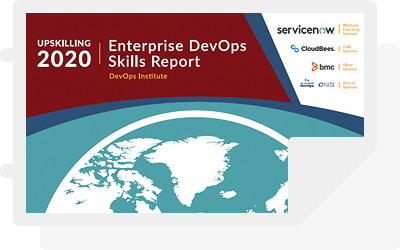Going Digital with Devops
Keeping customers happy is a top priority for enterprise organizations and critical to staying ahead of the competition. Since nearly every interaction with customers is digital, this means delivering a steady stream of new and compelling applications and services and ensuring that every customers’ experience is exceptional. Enterprises are scrambling to transform and optimize their digital capabilities and offerings, a shift that demands faster and smoother transitions between development (dev) and operations (ops) teams.
“DevOps is a practice that emphasizes the collaboration and communication of both software developers and other information-technology (IT) professionals while automating the process of software delivery and infrastructure changes. It aims at establishing a culture and environment where building, testing, and releasing software, can happen rapidly, frequently, and more reliably.” courtesy Wikipedia.com
DevOps practices can help enterprises to accelerate their digital transformation and to deliver software changes and applications to production environments faster. Improved communications through this alignment helps developers and operations teams quickly share actionable feedback.
Digital Transformation
Successfully optimizing digital capabilities and services requires informed decision-making, rapid reaction to changing demands, efficient processes and collaborative DevOps practices to continuously deliver high quality software.
Enterprise organizations can streamline and accelerate digital transformation and maximize the benefits of DevOps across enterprise architecture by leveraging these four best practices:
- Agile principles for dev and ops
- Shift left
- Increase re-usability
- Dev and ops together
Agile Principles for Dev and Ops
“Agile software development is a set of principles for software development in which requirements and solutions evolve through collaboration between self-organizing, cross-functional teams. It promotes adaptive planning, evolutionary development, early delivery, and continuous improvement, and it encourages rapid and flexible response to change.” courtesy Wikipedia.com
Agile development practices enable dev teams to generate quality builds at a faster pace, but ops teams may find it hard to keep up without the right tools. To close this gap, ops teams are becoming more agile and better able to respond rapidly and flexibly to change. For example, by using software release management to automate and coordinate application release processes across the entire lifecycle in order to mitigate risk and meet demand as the volume, frequency, and complexity of applications grow.
Both dev and ops teams can improve their agility and adopt an “inspect and adapt” approach with tools that provide end-to-end visibility. They can easily track application development, QA, and production from a central hub, and monitor how applications, configurations, and environments fit together to collectively understand the implications of change and adapt accordingly. By using customized templates, they can ensure continuous integration and delivery, while automation capabilities streamline and accelerate complex, multi-tier application deployments.
Shift Left Focus
“Shift Left” is the process of detecting and fixing software bugs earlier in the development process in order to improve quality and cost effectiveness. It requires involvement of Ops, QA, Testing, and Security aspects early in the development process.
When information about the relevant components, problems, and vulnerabilities is available early in the cycle, teams can:
- Improve release cycle planning
- Make product quality more predictable and reliable
- Reduce total cost of ownership (TCO)
Increase Reusability
Reusing existing data as well as proven software functions, components, frameworks, templates, and code can help reduce duplicative work as well as errors. However, the reusability efforts must occur across the value chain and throughout the enterprise in order to have the greatest impact. Having a well-defined technical roadmap as well as a single code repository are two best practices for promoting reusability and prioritization of tasks, which ultimately improves delivery and management.
“Dev and Ops” Instead of “Dev versus Ops”
Using the same tools for change tracking and task allocations enables dev and ops teams to collaborate more efficiently across organizational boundaries and helps to create better visibility and traceability across the software delivery lifecycle. Real-time collaboration using a common tool also helps with communication and data sharing.
Improved collaboration can also lead to better-designed software features and products as dev teams gain insight into how the product is functioning in production, they develop an appreciation of product nuances and can better design and develop usable enhancements. Similarly, when the ops team understands the development process and the technical roadmap, they are able to drive continuous process improvements by prioritizing tasks and sharing valuable insights, resulting in more reliable and more easily managed software.
Conclusion
DevOps alignment is critical to accelerating digital transformation initiatives, enabling organizations to continuously assess and dynamically adapt to business, customer and market demands. These four best practices help enterprise architecture teams to create a collaborative DevOps culture that welcomes and accelerates digital change. Implemented properly, DevOps enables early feedback from customers or users to work into agile development sprint cycles to optimize competitive advantage and helps to prevent issues that negatively affect customer satisfaction and revenue. By working collaboratively, dev and ops teams can focus on digital initiatives to stay ahead of the competition, rather than constantly fighting fires just to keep up.





